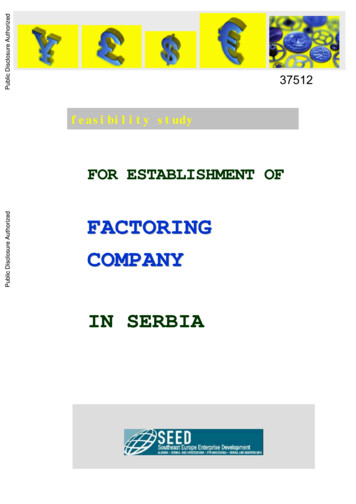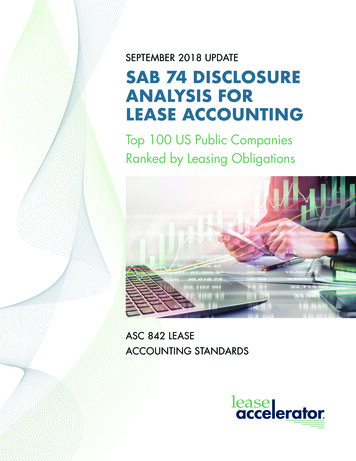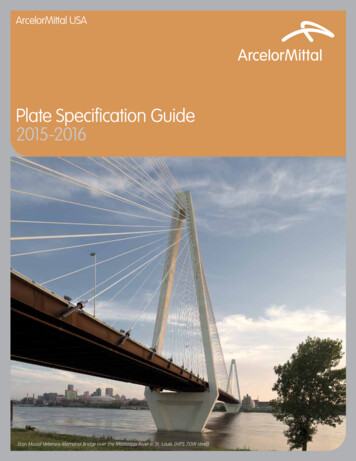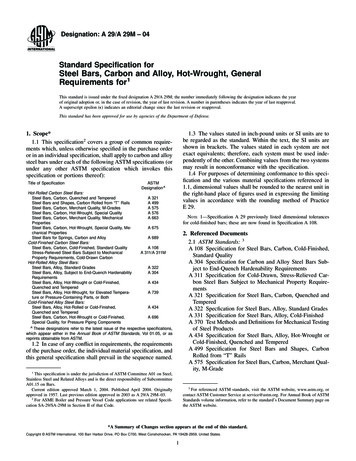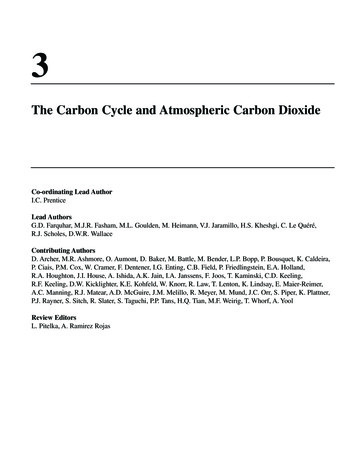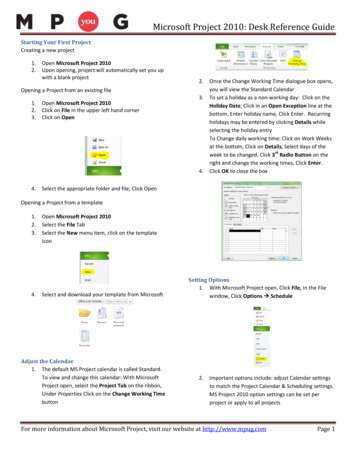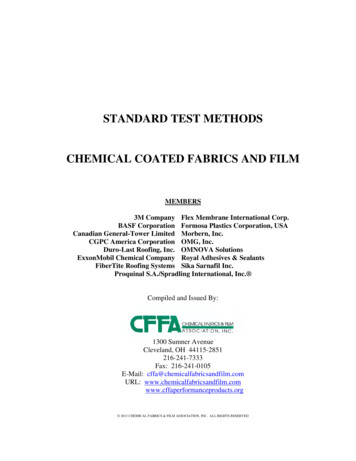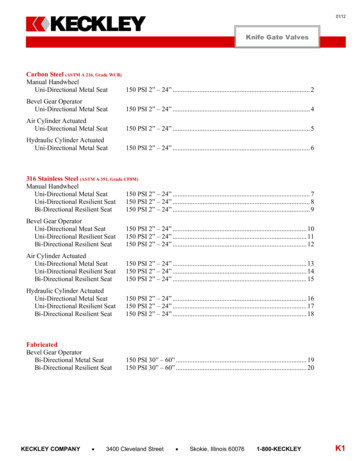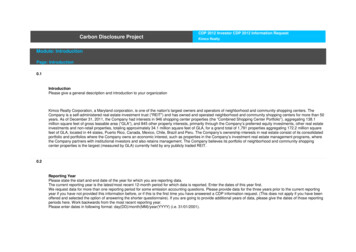
Transcription
Carbon Disclosure ProjectCDP 2012 Investor CDP 2012 Information RequestKimco RealtyModule: IntroductionPage: Introduction0.1IntroductionPlease give a general description and introduction to your organizationKimco Realty Corporation, a Maryland corporation, is one of the nation's largest owners and operators of neighborhood and community shopping centers. TheCompany is a self-administered real estate investment trust ("REIT") and has owned and operated neighborhood and community shopping centers for more than 50years. As of December 31, 2011, the Company had interests in 946 shopping center properties (the “Combined Shopping Center Portfolio”), aggregating 138.1million square feet of gross leasable area (“GLA”), and 845 other property interests, primarily through the Company’s preferred equity investments, other real estateinvestments and non-retail properties, totaling approximately 34.1 million square feet of GLA, for a grand total of 1,791 properties aggregating 172.2 million squarefeet of GLA, located in 44 states, Puerto Rico, Canada, Mexico, Chile, Brazil and Peru. The Company’s ownership interests in real estate consist of its consolidatedportfolio and portfolios where the Company owns an economic interest, such as properties in the Company’s investment real estate management programs, wherethe Company partners with institutional investors and also retains management. The Company believes its portfolio of neighborhood and community shoppingcenter properties is the largest (measured by GLA) currently held by any publicly traded REIT.0.2Reporting YearPlease state the start and end date of the year for which you are reporting data.The current reporting year is the latest/most recent 12-month period for which data is reported. Enter the dates of this year first.We request data for more than one reporting period for some emission accounting questions. Please provide data for the three years prior to the current reportingyear if you have not provided this information before, or if this is the first time you have answered a CDP information request. (This does not apply if you have beenoffered and selected the option of answering the shorter questionnaire). If you are going to provide additional years of data, please give the dates of those reportingperiods here. Work backwards from the most recent reporting year.Please enter dates in following format: day(DD)/month(MM)/year(YYYY) (i.e. 31/01/2001).
Enter Periods that will be disclosedSat 01 Jan 2011 - Sat 31 Dec 20110.3Country list configurationPlease select the countries for which you will be supplying data. This selection will be carried forward to assist you in completing your responseSelect countryUnited States of AmericaPuerto Rico0.4Currency selectionPlease select the currency in which you would like to submit your response. All financial information contained in the response should be in this currency.USD( )0.5Please select if you wish to complete a shorter information request0.6Modules
As part of the Investor CDP information request, electric utilities, companies with electric utility activities or assets, companies in the automobile or auto componentmanufacture sectors and companies in the oil and gas industry should complete supplementary questions in addition to the main questionnaire.If you are in these sectors (according to the Global Industry Classification Standard (GICS)), the corresponding sector modules will be marked as default options toyour information request. If you want to query your classification, please email respond@cdproject.net.If you have not been presented with a sector module that you consider would be appropriate for your company to answer, please select the module below. If youwish to view the questions first, please see ore-questionnaires.aspx.Module: Management [Investor]Page: 1. Governance1.1Where is the highest level of direct responsibility for climate change within your company?Senior Manager/Officer1.1aPlease identify the position of the individual or name of the committee with this responsibilityMike Pappagallo, Chief Operating Officer1.2Do you provide incentives for the management of climate change issues, including the attainment of targets?Yes1.2a
Please complete the tableWho is entitled to benefitfrom these incentives?The type ofincentivesChief Operating Officer (COO)MonetaryrewardBusiness unit managersMonetaryrewardFacility nagersMonetaryrewardEnergy managersMonetaryrewardIncentivised performance indicatorMonetary compensation is, in part, tied to the performance of Kimco’s energy management and sustainabilityprograms. As the use of electricity is the primary driver of GHG emissions for the company, this individual isevaluated on the basis of the company’s energy expense.Monetary compensation is, in part, tied to the performance of Kimco’s energy management and sustainabilityprograms. As the use of electricity is the primary driver of GHG emissions for the company, this individual isevaluated on the basis of the company’s energy expense.Monetary compensation is, in part, tied to the performance of Kimco’s energy management and sustainabilityprograms. As the use of electricity is the primary driver of GHG emissions for the company, this individual isevaluated on the basis of individual property-level energy expense.Monetary compensation is wholly tied to the performance of Kimco’s energy management and sustainabilityprograms (the use of electricity is the primary driver of GHG emissions for the company). For example, theattainment of energy expense reduction targets and the development of new business related toenergy/climate change services.Monetary compensation is wholly tied to the performance of Kimco’s energy management programs (the useof electricity is the primary driver of GHG emissions for the company). For example, the attainment of energyexpense reduction targets and the development of new business related to energy/climate change services.Page: 2. Strategy2.1Please select the option that best describes your risk management procedures with regard to climate change risks and opportunitiesIntegrated into multi-disciplinary company wide risk management processes2.1aPlease provide further details (see guidance)
Risks from climate change are currently managed as a part of established governance and risk management processes within the company. Risk managementwithin Kimco is a multi-stakeholder process that involves all of the key functional areas within the company. Ultimate accountability for corporate risk managementresides with the senior executive team, with oversight from the Board of Directors. Kimco’s core business of acquiring, leasing, and managing properties isconducted at the regional level with central oversight from the corporate executive team. Management efforts pertaining to climate risks and opportunities (whetherthey be physical, regulatory or other), including programs such as energy management, severe weather preparedness and response, and reputation managementare executed on an ongoing basis with national oversight by Kimco’s Vice President of Property Management and Director of Sustainability. During 2011 keymembers of the management and executive team including the VP of Property Management, Director of Sustainability ,CAO and COO met on a quarterly basis toreview the company’s approach to climate and other sustainability-related risks and opportunities for the company. For the first time, an overarching strategy forsustainability was created and presented to members of the executive team. Included in the strategy was the identification of key driving factors for the expansion ofKimco’s programs. Specifically cited were potential risks associated with commodity price fluctuations, future regulation, weather-related damage to properties,obsolescence of existing real estate assets in the minds of prospective tenants, and investor/joint venture partner interest in our portfolio. Also included were avariety of potential opportunities to create ancillary income and increased market competitiveness for the company. Potential risks and opportunities were exploredat both the corporate level as well as the individual asset level – contrasting those issues that primarily impact the corporate parent versus individual property-levelentities. A key focus of Kimco’s actions in this area is to generate long-term value for the organization by optimizing expenses, creating additional sources of incomeand enhancing our reputation among key stakeholder groups. At the individual property level, we focus on managing those risks and opportunities that have a directimpact on Net Operating Income (NOI). At the corporate level, our focus is on driving holistic programs that will help the company to meet its year-over-yearfinancial goals and to protect or enhance our reputation. Moving forward, we will continue to re-assess and review these issues on a quarterly basis.2.2Is climate change integrated into your business strategy?Yes2.2aPlease describe the process and outcomes (see guidance)We view climate related strategy, in particular those actions taken to minimize expense and contribute to existing or additional sources of income, as directlyinfluencing the Net Operating Income (NOI) of individual properties within our portfolio. As such, these actions are central to our overall business strategy. Over thepast several years, Kimco has taken significant steps to re-align resources to more effectively integrate climate change into our business strategy. The appointmentof a national Vice President of Property Management, the hiring of a full-time national Director of Sustainability, and the hiring of a full-time Manager of EnergyServices were actions taken in order to enhance our capability to develop processes and programs to execute company-wide initiatives such as energymanagement and tenant energy services. In the short-term, our efforts are focused on establishing a high-quality set of building performance data with respect toenergy use, carbon emissions, water use, and other related sustainability factors. In 2011, we created and validated a historical database of energy and waterconsumption data from utility invoices. This effort, when paired with a new capability to generate real-time usage data via property sub-metering, will enable Kimcoto establish and track universal performance metrics across our portfolio. As a result of our data collection efforts during 2011, Kimco was able to create a baselineinventory of Scope 1 and 2 greenhouse gas emissions for our U.S. properties. The GHG inventory, and underlying information about property-level energy
consumption, are critical inputs to an ongoing process within the company to identify inefficient property systems and prioritize performance improvements. Theprocess of measuring, implementing, and verifying results begins with good information. During 2011, Kimco began the implementation of a range of initiatives thatwill reduce our usage of energy, water, and other scarce resources. We have established a series of pilot programs – such as building controls and lighting retrofits- that once fully proven will be rolled out within our portfolio in order to optimize financial and environmental returns. Additional information on these programs isprovided in our response to question 3.2. Beyond operational efficiency measures, during 2011 Kimco evaluated and identified a number of income-generatingprograms relating to energy and climate change. We estimate that, at a typical shopping center property, the business operations of our tenants result in more than10 times the emissions than are created by our landlord-related activities. Additionally, we know that energy is typically the second largest operating expense for ourtenants – behind store payroll. Kimco believes that there are potential income opportunities tied to addressing tenant needs relating to energy and emissions, andhas validated this theory through the creation of a onsite solar energy business. Over the coming year, we take steps to expand this program as well as evaluateother potential programs to address tenant needs.2.2bPlease explain why not2.3Do you engage with policy makers to encourage further action on mitigation and/or adaptation?Yes2.3aPlease explain (i) the engagement process and (ii) actions you are advocatingWe engage with policy makers on issues of relevance to our business, most often through our involvement in industry associations such as the International Councilof Shopping Centers (ICSC) and the National Association of Real Estate Investment Trusts (NAREIT). We believe that issues relating to climate change, includingclimate policy, energy policy, building standards, and others are common challenges for all companies within our industry. Industry associations are an effectivemeans for communicating a cohesive and clear point-of-view to policy-makers on these topics. Kimco’s CEO, David Henry, recently served as the ICSC’s Board ofTrustees to serve as the association’s chairman for 2011-2012. Additionally, our Director of Sustainability is actively engaged with environmental working groupswithin ICSC and NAREIT. Both organizations are active in the policymaking process, and Kimco is working with each organization to define environmental prioritiesand take actions to proactively engage in sustainability-related policy issues. In 2011, Kimco participated in a series of ongoing meetings with representatives fromthe ICSC and fellow member companies to define policy and program priorities for the future. Related issues that were addressed included opportunities forlandlord-tenant collaboration, energy, greenhouse gas emissions, building rating systems, building codes and standards, etc.
Page: 3. Targets and Initiatives3.1Did you have an emissions reduction target that was active (ongoing or reached completion) in the reporting year?No3.1aPlease provide details of your absolute targetIDScope% ofemissions inscope% reduction frombase yearBase yearBase yearemissions(metric tonnesCO2e)Target yearComment3.1bPlease provide details of your intensity targetIDScope% ofemissions inscope% reductionfrom base yearMetricBase year3.1cPlease also indicate what change in absolute emissions this intensity target reflectsNormalized baseyear emissionsTarget yearComment
IDDirection of change anticipated inabsolute Scope 1 2 emissions attarget completion?% change anticipatedin absolute Scope 1 2emissionsDirection of change anticipated inabsolute Scope 3 emissions at targetcompletion?% change anticipatedin absolute Scope 3emissionsComments3.1dPlease provide details on your progress against this target made in the reporting yearID% complete (time)% complete (emissions)Comment3.1ePlease explain (i) why not; and (ii) forecast how your emissions will change over the next five yearsWe are working to analyze our baseline inventory of greenhouse gas emissions, and collect performance data on pilot emissions reduction programs, prior toestablishing reduction goals. We completed our baseline emissions inventory in 2011, and are disclosing the results for the first time this year. As a part of ourstrategic planning process, we will be conducting a goal scoping exercise within the next year. Regarding future emissions, we do not at this early stage have thenecessary data – including growth and reduction factors - to accurately forecast our emissions profile over the next five years. On an intensity basis, we anticipatethat our shopping centers will become more efficient over the next several years as we implement efficiency measures targeted at lighting and other major drivers ofenergy use. On an absolute basis, we anticipate the property acquisitions and divestitures will be a large driver of directional changes in our emissions total – but atthis point in time do not know the magnitude or direction of these impacts. We anticipate that, once complete, our data collection efforts will enable betterforecasting of emissions.3.2Does the use of your goods and/or services directly enable GHG emissions to be avoided by a third party?Yes3.2a
Please provide details (see guidance)As one of the nation’s largest retail landlords in the U.S., Kimco owns interests in community and neighborhood shopping centers with over 130 million square feet ofleasable space. We provide retailers across the U.S., Canada, Mexico and select Latin American markets with leasable space in which to operate their brick-andmortar retail operations. Kimco recognizes that while our emissions footprint is significant, the emissions resulting from the operation of our tenant’s retailoperations is many times larger. The majority of these emissions result from electricity purchased by individual tenants from local utility providers. We estimate thatthese tenant-generated emissions are greater than 10 times the amount of emissions generated as a result of landlord activities at our shopping centers. The retailspace that Kimco supplies has an influence on the greenhouse gas emissions resulting from tenant operations and as a landlord Kimco has the potential to influencetenant behavior. Kimco has an opportunity to partner with our tenants to reduce their emissions – through better alignment of economic incentives, sharing of bestpractices in energy management, the collection and dissemination of building performance data, better maintenance and upkeep of key energy-consuming assetslike HVAC equipment, building retrofits, and the supply of low-carbon energy. We are working to expand these efforts, and to develop innovative new serviceofferings such as on-site renewable energy for our tenants. Through our wholly-owned taxable REIT subsidiary, Center Sun LLC, Kimco provides tenants at 6 ofproperties with cost-competitive renewable energy through power purchase agreements (PPAs). We have expanded this program by 100% over the past 12 months,and expect to generate in excess of 3.5 million kilowatt hours of electricity from 6 solar systems under management in 2012. We remain committed to expandingand pursuing this and other tenant-related opportunities.3.3Did you have emissions reduction initiatives that were active within the reporting year (this can include those in the planning and/or implementationphases)Yes3.3aPlease identify the total number of projects at each stage of development, and for those in the implementation stages, estimated CO2e savingsStage of developmentUnder investigationTo be implemented*Implementation commenced*Implemented*Not to be implementedNumber of projects20040570Total estimated annual CO2e savings (only for rows marked *)
3.3bFor those initiatives implemented in the reporting year, please provide details in the table belowEstimatedannual CO2esavingsActivity typeDescription of activityEnergyefficiency:building fabricEnergyefficiency:building servicesLow carbonenergyinstallationOur cool roofing program incorporates reflective white-membrane materialsas a part of our regular schedule of roof replacement projects, reducing heatgain and HVAC energy usage for tenants.Our building controls program focuses on providing centralized control ofexterior lighting, irrigation, and other key systems – resulting in significantenergy and water savings.OtherAnnualmonetarysavings (unitcurrency)Investmentrequired (unitcurrency)PaybackperiodThrough our wholly-owned subsidiary, Center Sun LLC, we provide on-siterenewable energy to tenants.Through our centralized waste management program, Kimco is deliveringtenants with a lower-cost trash disposal alternative and dramaticallyreducing vehicle miles driven by consolidating multiple trash managementvendors for properties.3.3cWhat methods do you use to drive investment in emissions reduction activities?MethodDedicated budget for energyefficiencyCommentWe leverage our regular ex
Monetary compensation is wholly tied to the performance of Kimco’s energy management and sustainability programs (the use of electricity is the primary driver of GHG emissions for the company). For example, the attainment of energy expense reduction targets and the development of new business re


